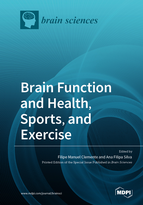Brain Function and Health, Sports, and Exercise
A special issue of Brain Sciences (ISSN 2076-3425). This special issue belongs to the section "Sensory and Motor Neuroscience".
Deadline for manuscript submissions: closed (31 March 2022) | Viewed by 55276
Special Issue Editors
Interests: football; soccer; match analysis; performance analysis; network analysis
Special Issues, Collections and Topics in MDPI journals
Interests: motor development; motor control and learning; exercise and brain function; sports training
Special Issues, Collections and Topics in MDPI journals
Special Issue Information
Dear Colleagues,
Sports and exercise have been related to acute and chronic changes in brain health and function. Regular exercise has been used as a non-pharmacological approach for protecting brain health while improving some brain functions. With benefits oberserved in young and old individuals and healthy and clinical populations, sports and exercise seem to play an important role in contributing to brain health and function. Despite some evidence regarding the contributions of sports and exercise to brain health and function, there is an increasing number of original research papers and systematic reviews with or without meta-analysis that may help professionals to identify which types of sport and exercise are suitable for specific improvements and the adequate duration of carrying out such activities. Additionally, there is space for further analysis of the contribution of sports and exercise to both the improvement of efficiency in work and to the mitigation of the effects of specific neurodegenerative diseases. Therefore, the Special Issue “Brain Function and Health, Sports, and Exercise” will include contributions from different areas of knowledge that may asssist in improving our understand ing of the relationships between sports and exercise and brain health and function. Original studies, systematic reviews, and meta-analysis on the following main topics are welcome (but not exclusively): (i) role of exercise in neurodegenerative diseases; (ii) role of sport and exercise in cognitive performance; (iii) role of sport and exercise in brain health; (iv) effects of different sport and exercise modes on brain function and health; and (v) dose–response relationships between exercise and brain health and function.
Dr. Filipe Manuel Clemente
Dr. Ana Filipa Silva
Guest Editors
Manuscript Submission Information
Manuscripts should be submitted online at www.mdpi.com by registering and logging in to this website. Once you are registered, click here to go to the submission form. Manuscripts can be submitted until the deadline. All submissions that pass pre-check are peer-reviewed. Accepted papers will be published continuously in the journal (as soon as accepted) and will be listed together on the special issue website. Research articles, review articles as well as short communications are invited. For planned papers, a title and short abstract (about 100 words) can be sent to the Editorial Office for announcement on this website.
Submitted manuscripts should not have been published previously, nor be under consideration for publication elsewhere (except conference proceedings papers). All manuscripts are thoroughly refereed through a single-blind peer-review process. A guide for authors and other relevant information for submission of manuscripts is available on the Instructions for Authors page. Brain Sciences is an international peer-reviewed open access monthly journal published by MDPI.
Please visit the Instructions for Authors page before submitting a manuscript. The Article Processing Charge (APC) for publication in this open access journal is 2200 CHF (Swiss Francs). Submitted papers should be well formatted and use good English. Authors may use MDPI's English editing service prior to publication or during author revisions.
Keywords
- sports
- exercise
- physical activity
- brain health
- brain function
- brain activity
- dose–response relationship








